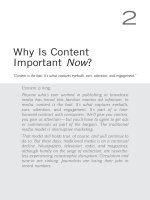Content marketing think like a publisher chapter 11 content and SEO
Bạn đang xem bản rút gọn của tài liệu. Xem và tải ngay bản đầy đủ của tài liệu tại đây (496.58 KB, 8 trang )
11
Content and SEO
“Nothing matters more in search engine optimization than content. Nothing.”
Sure, technical aspects of a site play a large factor, as
does site architecture. A few things done improperly or
mismanaged (for example, a robots.txt file, a line of code
that prevents a search engine from even seeing online content) can torpedo search engine optimization (SEO)
efforts. But when it comes to having a well-optimized web
presence that’s visible to search engines, content is the
alpha and omega of those efforts. More specifically, written content matters. Search engines can only crawl, index,
and understand text—not images, videos, podcasts, photos, or any other type of graphic or multimedia content.
That’s not to say you can’t optimize nontext content marketing elements. We’ll examine how later in this chapter.
98
Part III
G e t t i n g Ta c t i c a l : C o n t e n t N u t s & B o l t s
Keywords Are Key
Strong, optimized written copy is the most critical part of any SEO initiative.
However, before the first sentence, tagline, or headline is written, be sure to identify
those keywords and key phrases your target audience is likely to use when searching for your website, articles, blog entries, or other content initiatives. Also, make
sure you do the same for individual pages or specific pieces of content within a
website or blog.
These are the words and phrases searchers use, not necessarily the ones you use
back at the office when you’re talking with colleagues. Perhaps you’re a medical
professional who bandies about terms such as “myocardial infraction.” The average
Web searcher is more likely to seek information on “heart attack.”
The first step in the keyword research process is simply to brainstorm a list of the
words and phrases a searcher might use to find your site or business. The trick here
is to be specific. Forget broad terms like “shoes.” Focus instead on “running shoes”
or “wedding shoes” or “Nike running shoes” or “black patent leather high-heeled
pumps.” It can be helpful to ask outsiders such as friends, family, clients, or colleagues what terms come to mind.
After the initial list is in hand, the next step is to determine how useful these terms
really are. That’s where keyword research tools come in handy.
Note
Both Google and Bing offer free keyword research tools. They require you to
first sign up for an advertiser account, but no worries—they don’t compel
you to run ads to use the free tools.
By running the list of proposed keywords through a keyword research tool, you’ll
learn how many searchers are actually conducting searches for a given word or
term every day, how many of those searches actually converted into sales or
another desired action (that is, a whitepaper download), and other analytical information. These tools can also make you aware of words not on the list, or synonyms.
This information should narrow down the selections to a final list of keywords.
Plug these into a spreadsheet that helps you visualize at a glance each word or
phrase’s conversion rate, search volume, and competition. This list helps narrow
your focus and concentrates on the most important terms for your content. Don’t
completely eliminate broad terms such as “shoes” because these give searchers a
general feel for what you’re offering. However, it’s the specific, targeted terms (“pink
suede ballerina flats”) that attract the targeted traffic at the bottom of the purchase
or conversion funnel.
Chapter 11
Content and SEO
99
The best keywords have certain characteristics:
• Strong relevance—Terms for which you have content to support.
• Relatively high search volume—Terms people actually search for.
• Relatively low competition—Terms with a small number of search
results, that is other pages on the Internet that search engines have
indexed as containing a specific word or phrase.
After you’ve determined which keywords to target—both for an overall content
marketing initiative as well as for specific, smaller campaigns—it’s time to build
content around those terms. Bear in mind that search engines reward high-quality,
original content more than virtually anything else out there. This is why content
aggregation is fine (and relevant), but also why aggregation should almost always
be regularly supplemented with well-written and researched original content.
A major way that search engine algorithms to determine quality content is by
examining how many links there are to specific pieces of content. Links can almost
be considered “votes” vouching for quality content. As far as search engines are
concerned, this isn’t the most democratic process in the world; a link from a major
metropolitan daily such as The New York Times is a higher-ranking vote than one
from, say, a random tweet on Twitter. And a link from a site that is semantically
similar obviously make more sense—and therefore counts more—than a link from
something willy-nilly, say a site about politics linking to a page about Christmas
cookie recipes.
One of the best strategies for getting people to link to you is, of course, to link to
them. Another approach is to follow relevant sites, blogs, online video channels,
and social networking presences in your particular vertical and to comment on
them, with appropriate and relevant links back to your own content. Authoring
articles and other types of content for third-party sites is also a valuable link strategy; most of these have an “about the author” blurb that creates a link back to your
own site or blog. Internal links are also highly valuable because links are what
search engine spiders follow to find content in the first place. This is where site
maps, tags, category pages, and well-considered taxonomies come in handy. They
not only help visitors find relevant content, they help search engines find it, too.
Making content as sharable as possible is another valuable link-building strategy.
It’s why so many sites contain those small icons encouraging visitors to “share on
Facebook or LinkedIn or Digg or Delicious,” or “Tweet this.” Individually, social
media links might not be as valuable as that New York Times citation, but many
sites are seeing highly significant portions of their traffic originating from social
media sites thanks to such efforts.
100
Part III
G e t t i n g Ta c t i c a l : C o n t e n t N u t s & B o l t s
To this end, content authors should also be regarded as important link-building
sources, particularly guest or third-party content contributors who can leverage links
through their own websites or social networks to build links that benefit both parties.
Crispin Sheridan, the senior director of search marketing at global software giant
SAP, led an initiative to integrate the company’s social media presence with SEO
that resulted in conversion rate increasing 250% (see Figure 11.1).
“We did a kind of a mini-audit and looked at how many social media sites that
seemed to be about SAP were out there. That’s when we discovered the large number of blogs—well, we already knew about the blogs,” said Sheridan. “I think the
22-plus active Twitter accounts came as a surprise, the 17-plus Facebook fan pages,
the various LinkedIn groups, a lot of content on YouTube, but none of it really
coming from official channels. So we realized there was a lot of activity going on.”
Figure 11.1 When SAP conducted an audit of the brand’s unofficial social media
presence, the results astounded the internal team. The company wasn’t producing a
great deal of content, but users were.
Sheridan’s team began using the keywords present in all those external social media
sites—the words and phrases people interested in the company were using when
they talked about the company and its products and services. The question posed:
“If we use those same keywords in social media activities such as Facebook fans
pages, wall posts, links—what kinds of traffic would we see, and would it be valuable traffic?”
The company built a Facebook fan page up to a statistically relevant sample size for
the organization. (Its target was 16,000 fans but now exceeds 25,000.) By using the
top value and highest converting keywords and phrases from its organic search
efforts, it began creating posts for the Facebook page with those same terms.
“That’s when we realized the traffic that was coming in [through social media
channels] was converting at 2.5 times the amount of organic search traffic,”
Sheridan says.
Chapter 11
Content and SEO
101
“We believe the high conversion rate is because these people are very much
engaged; they’re the ones we call the e-fluentials. They’re the ones who are beginning to reach out to their peers and consult other people, which usually means
they’re farther down in the buying cycle than the people who are kicking the tires.
Maybe they don’t want to talk with a salesperson yet, be bothered, or even divulge
that they’re looking, but we found that the people coming to us seem to be at a
lower stage in the funnel: the buying process.”
This is a stunning example of applying SEO principles to social media and other content channels, not to mention a solid reason for having keyword research in place.
Optimize Images and Multimedia Content
As stated in the opening of this chapter, search engines can’t read anything other
than plain old text. They can’t watch a video, listen to an audio file, or assign a
thousand words to a picture. So to optimize images and multimedia content for
search, you have to create the words for the search engines.
What all these file types have in common is a need for clear, descriptive names or
titles. These are not by any means the default name spit out by audio, video, or
image software, such as img230769.jpg. Filenames should be as descriptive as possible and match what the file represents.
If you have a shot of an apple, for example, call it a “New York State Macintosh
Apple,” or “Ripe Harvest Orchard’s Macoun Apple,” not just plain old “apple.” For all
a search engine knows, that “apple” could be a computer or even a mobile phone.
Such descriptive names not only are found by search engine spiders, they often
have the added advantage of appearing above, below, or by the image itself, enhancing the user experience as well. Beyond any other optimization tactics, filenames
are accorded the most weight by search engines when it comes to ranking.
It should, therefore, come as no surprise that websites that regularly use multiple
media files require a naming strategy or protocol to ensure consistency in the
names used for graphics, audio, or video.
After giving media files clear, descriptive names, don’t forget to add more descriptive text (or meta data) to the “alt” attribute in the file’s tag. Make it short and to the
point, like the filename. This is an opportunity to go a little bit broader. That New
York State apple, for example, might be from Olsen’s Orchards or have been a product of the 2011 harvest, or perhaps this is the place to indicate it’s a sweet, crisp,
delicious, and nutritious apple.
Online merchants might want to use this field to add information such as a manufacturer, product category, or UPC code.
102
Part III
G e t t i n g Ta c t i c a l : C o n t e n t N u t s & B o l t s
Let’s say you sell DVDs online. The name of the media file, in this case a photo of
the cover art, would obviously be the title of the film. The “alt” attribute might
include the names of the actors, director, studio, genre, release year, and any miscellaneous information such as “Academy Award Nominee.”
Perhaps the media file in question is named “Lady Gaga on American Idol.” The
meta data might refer to the specific contestant in the competition or the names of
other judges, or it might list some of the singer’s credits, so the video shows up on
more general searches by her fans.
Keyword strategy, combined with content marketing goals, will inform what type of
additional data is added in this section.
A caption adjacent to an image or media file helps search engines “understand”
what the file is about because adjacent text helps search engines contextualize what
they’ve found and determine relevancy. The goal here is to function much like a
newspaper or a magazine by adding keyword-rich captions to files. This way, even
if someone’s been careless and named an image file Bass.jpg, the adjacent text and
caption can help a search engine understand if the image depicts a fish, a musical
instrument, or a particular brand of shoe. This approach can be broadened to optimizing the entire page the media file resides on to further increase the depth of
context and relevancy.
In the case of images, file type matters. Photos should be rendered in .jpg format,
and logos should be .gif files. The reason is simply that these are standard formats
that search engines “expect” to find. Search engines assume a .gif file has 256 colors,
which is standard for rendering graphics such as logos, whereas photos are rendered in millions of colors. And when using logo files, it’s all-important that the file
be named with whatever’s in that logo. No search engine is smart enough to deduce
that a simple .gif file represents the logo for Bank of America, Ikea, or Acme
Exterminating.
Although it can be labor-intensive, posting a Hypertext Markup Language (HTML)
transcript of the dialogue in an audio or video file goes extraordinarily far in terms
of optimizing the actual content of these media files. Given the nature of the
medium, it’s best to keep these files short—optimally five minutes or less (particularly in the case of video). Cutting longer media files into shorter segments not only
eases viewing, but also affords additional opportunities to optimize the content and
to provide extra, spider-able links between episodes or installments. This is particularly helpful in the case of episodic videos or podcasts.
Chapter 11
Content and SEO
103
Quality Matters—So Does Specificity
It’s not just content that reigns supreme in SEO; it’s
quality content. Google’s own published guidelines
on the topic say in essence that all those hoping to
rank well in search should write for their own visitors and users, not for the search engines themselves. The company is putting its algorithms
solidly behind this recommendation. In recent
years, we’ve seen content farms, which are websites
that churn out mountains of garbage content to
game the search engines and rise to the top of
organic search results, plummet, and in many cases
even disappear from search rankings.
“It’s not just
content that
reigns supreme
in SEO;
it’s quality
content.”
Creating a lot of garbage is, of course, cheap and easy. Creating—and sustaining the
creation of—high-quality content requires thought and investment (particularly
when everyone else is trying to do it, too).
There are plenty of good reasons to keep content interesting, informative, entertaining, engaging, witty, useful, well written and well presented. Dozens of reasons
to have a strong taxonomy, descriptive and compelling headlines, tags, and other
organizational attributes. Now you can add SEO to that list, too. You may be creating and publishing the best content on the Web—but what does that matter if no
one can find it?
This page intentionally left blank









